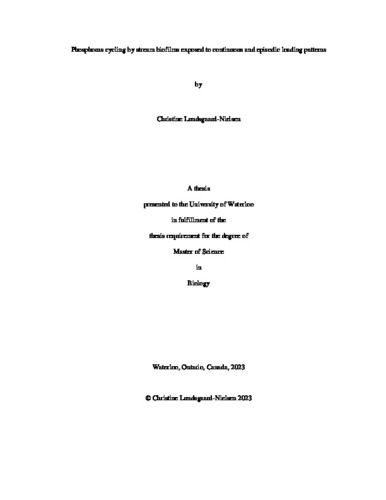UWSpace will be migrating to a new version of its software from July 29th to August 1st. UWSpace will be offline for all UW community members during this time.
Phosphorus cycling by stream biofilms exposed to continuous and episodic loading patterns
| dc.contributor.author | Lundsgaard-Nielsen, Christine | |
| dc.date.accessioned | 2023-09-25 20:14:45 (GMT) | |
| dc.date.available | 2023-09-25 20:14:45 (GMT) | |
| dc.date.issued | 2023-09-25 | |
| dc.date.submitted | 2023-09-14 | |
| dc.identifier.uri | http://hdl.handle.net/10012/19940 | |
| dc.description.abstract | Anthropogenic activities have led to nutrient enrichment of streams, causing eutrophication of water bodies on a global scale. Eutrophication is frequently tied to an excessive influx of phosphorus (P); a crucial nutrient that often limits productivity in freshwater ecosystems. Strategies for tackling eutrophication increasingly rely on watershed models, which predict when and how much P is carried from land to water bodies. However, some watershed models overlook the in-stream cycling of P, potentially hindering eutrophication management by miscalculating P loads to waterbodies. Stream biofilms may play an important role in P cycling through P retention and transformation. However, understanding of these processes within biofilms is limited, particularly in the context of continuous (i.e., point source) and episodic (i.e., non-point source) P delivery patterns to streams. To address the knowledge gap in P cycling by stream biofilms, I investigated the potential of stream biofilms to act as P sinks and reactors under continuous and episodic loading patterns. This was achieved through a 25-day experiment in artificial streams using three treatment levels of soluble reactive phosphorus (SRP) loading: 1) unenriched – a constant 10 μg P/L concentration; 2) episodically enriched – a constant 10 μg P/L concentration with a 48-hour pulse of 400 μg P/L; and 3) continuously enriched – a constant 40 μg P/L concentration. The study aimed to compare patterns of P transformation, retention, and uptake amongst these loading patterns. Results showed that approximately 15% of the SRP load was retained within the biofilm across all loading patterns. 75% of the SRP load was transformed into different P forms under unenriched and continuously enriched patterns. In contrast, the episodically enriched biofilms transformed 60% of the SRP load. The biofilms’ ability to transform and uptake P decreased during the second day of the pulse, suggesting that the extended duration and high concentration of the pulse overwhelmed the biofilms in the episodic loading pattern. Stream biofilms demonstrated potential to act as both P reactors and P sinks and may help to delay P loads and reduce P bioavailability in downstream ecosystems. However, the ability of stream biofilms to transform P delivered in an episodic loading pattern may be reduced compared to continuous loading patterns, depending on the concentration and duration of the pulse. Maximizing P transformation by stream biofilms could involve delivering P in a continuous rather than an episodic loading pattern where feasible. Integrating biofilm P cycling into watershed models could prove beneficial, but its impact might vary depending on modeled time scales and P species. This research highlights the influence of biofilms on nutrient dynamics in stream ecosystems and emphasizes the need for their inclusion in ecosystem management strategies. | en |
| dc.language.iso | en | en |
| dc.publisher | University of Waterloo | en |
| dc.subject | phosphorus | en |
| dc.subject | biofilm | en |
| dc.title | Phosphorus cycling by stream biofilms exposed to continuous and episodic loading patterns | en |
| dc.type | Master Thesis | en |
| dc.pending | false | |
| uws-etd.degree.department | Biology | en |
| uws-etd.degree.discipline | Biology | en |
| uws-etd.degree.grantor | University of Waterloo | en |
| uws-etd.degree | Master of Science | en |
| uws-etd.embargo.terms | 0 | en |
| uws.contributor.advisor | Yates, Adam | |
| uws.contributor.affiliation1 | Faculty of Science | en |
| uws.published.city | Waterloo | en |
| uws.published.country | Canada | en |
| uws.published.province | Ontario | en |
| uws.typeOfResource | Text | en |
| uws.peerReviewStatus | Unreviewed | en |
| uws.scholarLevel | Graduate | en |

